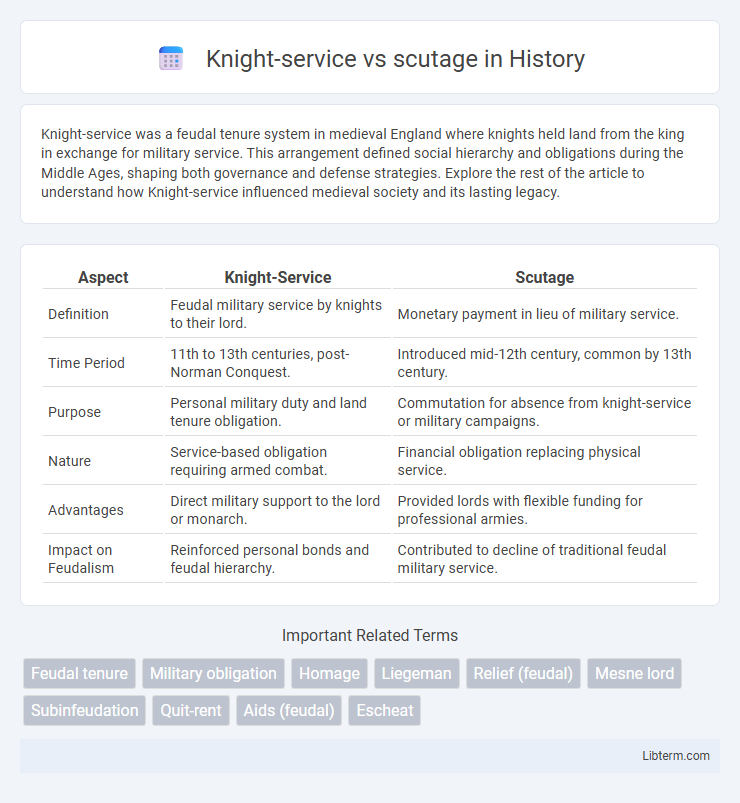Knight-service was a feudal tenure system in medieval England where knights held land from the king in exchange for military service. This arrangement defined social hierarchy and obligations during the Middle Ages, shaping both governance and defense strategies. Explore the rest of the article to understand how Knight-service influenced medieval society and its lasting legacy.
Table of Comparison
| Aspect | Knight-Service | Scutage |
|---|---|---|
| Definition | Feudal military service by knights to their lord. | Monetary payment in lieu of military service. |
| Time Period | 11th to 13th centuries, post-Norman Conquest. | Introduced mid-12th century, common by 13th century. |
| Purpose | Personal military duty and land tenure obligation. | Commutation for absence from knight-service or military campaigns. |
| Nature | Service-based obligation requiring armed combat. | Financial obligation replacing physical service. |
| Advantages | Direct military support to the lord or monarch. | Provided lords with flexible funding for professional armies. |
| Impact on Feudalism | Reinforced personal bonds and feudal hierarchy. | Contributed to decline of traditional feudal military service. |
Introduction to Knight-Service and Scutage
Knight-service was a medieval feudal tenure demanding military service from tenants to their lord in exchange for land, typically involving personal attendance in battle. Scutage emerged as a monetary payment allowing knights to avoid direct military duty by compensating the lord financially instead. This shift from obligatory service to commutation through scutage marked a significant evolution in feudal obligations and land tenure systems during the Middle Ages.
Historical Origins of Knight-Service
Knight-service originated during the feudal system in medieval England, where vassals provided military service to their lords in exchange for land tenure. This obligation required knights to serve in their lord's army for a set period annually, usually forty days. Scutage later emerged as a monetary payment allowing tenants to commute this military duty, reflecting the evolving nature of feudal obligations.
The Evolution of Feudal Military Obligations
Knight-service initially required vassals to provide personal military service to their lords, typically serving as heavily armored cavalry for a fixed period each year during the height of feudalism. Over time, this obligation evolved into scutage, a monetary payment made by vassals in lieu of direct military service, allowing lords to hire professional soldiers and create more flexible, centralized armies. This transformation marked a shift from personalized feudal warfare toward a more monetized and bureaucratic military system, reflecting broader social and economic changes in medieval Europe.
Defining Scutage: A Monetary Alternative
Scutage represents a monetary payment made by medieval vassals to their lords as an alternative to the traditional knight-service, which required personal military duty. This financial substitute allowed tenants to fulfill their feudal obligations without physically serving in military campaigns. The development of scutage facilitated the shift from feudal military service to a system where lords could hire professional soldiers using the collected funds.
Motivations Behind the Shift from Knight-Service to Scutage
Economic pressures and the increasing complexity of military obligations motivated the shift from knight-service to scutage in medieval England. Landholders sought to avoid personal military service by paying scutage, a monetary fee that allowed the king to hire professional soldiers, ensuring more reliable defense. This transition reflected evolving feudal relationships and the crown's need for flexible, efficient military funding.
Impact on Medieval Nobility and Landholders
Knight-service required medieval nobility to provide military service personally, reinforcing feudal bonds and directly linking tenure to battlefield obligations. Scutage allowed landholders to pay a monetary fee instead of military service, shifting responsibilities from personal combat to financial contributions, which gradually undermined traditional feudal military roles. This transition empowered nobles to monetize their obligations, altering land tenure dynamics and increasing the use of professional armies over feudal levies.
Economic and Political Consequences of Scutage
Scutage transformed feudal military obligations into monetary payments, allowing lords to hire professional armies, which increased the efficiency and centralization of military power. Economically, this shift facilitated the growth of a cash-based economy by converting knight-service into a predictable source of revenue for the crown. Politically, scutage weakened the traditional feudal bonds by reducing the knight's personal military service, thereby enhancing royal authority and weakening the independent military power of the nobility.
Case Studies: Notable Instances of Scutage in Action
Notable instances of scutage in medieval England highlight its role as a monetary alternative to knight-service, with King Henry II's reign featuring documented cases where barons paid scutage to avoid military obligations. During King John's rule, extensive use of scutage enabled the crown to fund campaigns without deploying knights, revealing the fiscal shift from feudal duties to cash payments. The Magna Carta of 1215 addressed abuses of scutage payments, limiting excessive levies and underscoring the tension between feudal service and financial exactions.
Decline of Knight-Service in Late Medieval England
Knight-service, a feudal military obligation requiring tenants to provide mounted soldiers, declined in Late Medieval England due to the rise of scutage--a monetary payment allowing tenants to commute military duties. This shift reduced the reliance on feudal levies, facilitating the crown's use of professional armies and centralized fiscal policies. The transition contributed to the erosion of traditional feudal bonds, reshaping military and land-tenure systems by the 14th and 15th centuries.
Legacy of Knight-Service and Scutage in Modern Understanding
Knight-service established a feudal tenure system where tenants provided military service to their lords, shaping medieval landholding and obligations. Scutage emerged as a monetary substitute, allowing knights to pay instead of serving personally, introducing early forms of commutation for military duties. Modern understanding views knight-service as foundational to the evolution of feudal military obligations, while scutage is recognized as a precursor to modern taxation and contracts replacing physical service with monetary payment.
Knight-service Infographic

 libterm.com
libterm.com